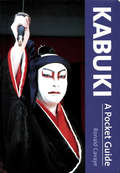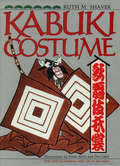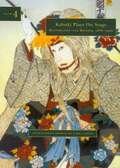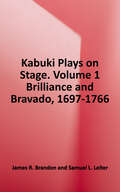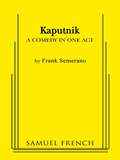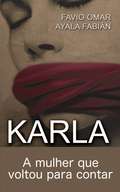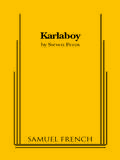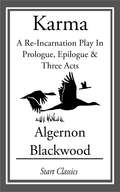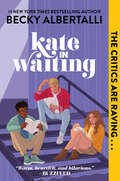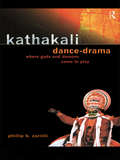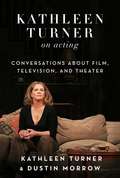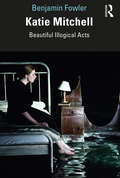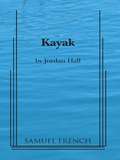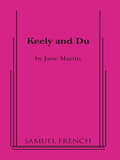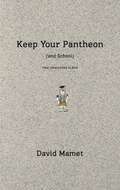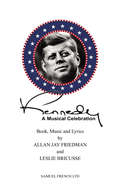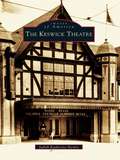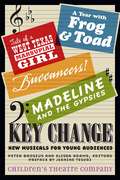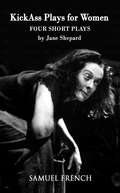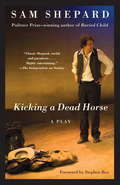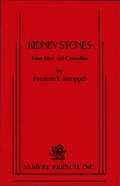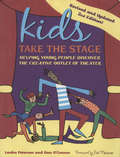- Table View
- List View
Kabuki A Pocket Guide
by Ronald CavayeConcise enough to take to performances, this pocket guide to Kabuki provides a wealth of fascinating information about the plays, the actors, and their history. As only an insider can do, the author takes us behind the scene to meet the actors, attend rehearsal, and get a first-hand look at the makeup, costumes, sets and props that go into a Kabuki performance.
Kabuki A Pocket Guide
by Ronald CavayeConcise enough to take to performances, this pocket guide to Kabuki provides a wealth of fascinating information about the plays, the actors, and their history. As only an insider can do, the author takes us behind the scene to meet the actors, attend rehearsal, and get a first-hand look at the makeup, costumes, sets and props that go into a Kabuki performance.
Kabuki Costume
by Ruth M ShaverOf the numerous books in English dealing with the Kabuki theater of Japan, none so far has devoted itself exclusively to costume. And yet costume is undeniably one of the outstanding features of this exciting form of drama. For the essence of Kabuki is spectacle, and the splendor of its costumes is one of the compelling reasons for going to see it. And here, at long last, in this engagingly written and gorgeously illustrated book, Kabuki Costume is given the full attention that it deserves.
Kabuki Costume
by Ruth M ShaverOf the numerous books in English dealing with the Kabuki theater of Japan, none so far has devoted itself exclusively to costume. And yet costume is undeniably one of the outstanding features of this exciting form of drama. For the essence of Kabuki is spectacle, and the splendor of its costumes is one of the compelling reasons for going to see it. And here, at long last, in this engagingly written and gorgeously illustrated book, Kabuki Costume is given the full attention that it deserves.
Kabuki Costume
by Ruth M ShaverThe attire of the feudal lords and ladies of old Japan, warriors, priest, courtesans, Edo-period dandies geisha, footmen, farmers- in fact, the whole array of Kabuki's colorful characters-is discussed in fascinating detail in this Japanese Kabuki book.From kimono and armor to undergarments, from wigs to foot gear, from swords to hair garments-no aspect of costume accessories is overlooked. Textiles and textile designs, in all their profusion of weaves, colors, and patterns, are carefully taken note of, and a number of important traditional designs are illustrate. Make-up and headdress varying formats of costume for specific roles, styles of tying the obi--all are expertly described.Of the numerous books in English dealing with the Kabuki theater of Japan, none so far has devoted itself exclusively to costume. Kabuki is compelling bringing about such art forms, yet it is the costumes that create the intrinsic, eye catching spectacle.Praise for Kabuki Costume:"A product of over fourteen years of meticulous study, Shaver's unique and authoritative analysis of the labyrinthine complexities of Kabuki costumery not only provides...a valuable reference work for scholar, but also an apt introduction for anyone seeking to understand the principles of Japanese visual arts and theatrical conventions."-Choice Reviews
Kabuki Plays On Stage Restoration and Reform: 1872-1905 Volume 4
by James R. Brandon Samuel L. LeiterRestoration and Reform, 1872-1905, is the fourth and final volume in a monumental new series that traces kabuki's changing relations to Japanese society during the premodern era. The twelve plays translated in Volume 4 cover the remarkable Meiji period, which followed the restoration of the emperor as the leader of Japan. They reflect the years in which reform-minded leaders struggled to help Japan catch up with the West. Dramatists no less than others sought ways in which to bring their traditional art into the modern world and to bring international respectability to the national stage. Included are kabuki dance plays that strive to resemble nô and kyôgen; historical dramas that abandon theatrical fantasy and opt for accurate reproduction of ancient manners; domestic dramas featuring colorful heroes and heroines; pieces that introduce faddish Western properties and behavior; and a play that bridges the gap between the conventions of classical kabuki, Shakespeare, and modern psychological drama. Dominating the era are the works of Kawatake Mokuami, the last great Kabuki playwright, while the dramaturgy of literary scholar Tsubouchi Shôyô brings Kabuki into the twentieth century.
Kabuki Plays On Stage Volume 1: Brilliance And Bravado, 1697-1766
by James R. Brandon Samuel L. LeiterKabuki Plays On Stage represents a monumental achievement in Japanese theatre studies, being the first collection of kabuki play translations to be published in twenty-five years. Fifty-one plays, published in four volumes, vividly trace kabuki's changing relations to Japanese society during the premodern era. Volume 1 consists of thirteen plays that showcase early kabuki's scintillating and boisterous styles of performance and illustrates the contrasting dramatic techniques cultivated by actors in Edo (Tokyo) and Kamigata (Osaka and Kyoto). The twelve plays translated in Volume 2 cover a brief period, but one that saw important developments in kabuki architecture, acting, dance, and the manipulation of characters and themes. As the series title indicates, the plays were translated to capture the vivacity of performances on stage. The translations, each accompanied by a thorough introduction that contextualizes the play, are based not only on published texts but performance scripts and the study of the plays as they are performed in theatres today. Each volume is lavishly illustrated with rare woodblock prints in full color of Tokugawa- and Meiji-period productions as well as color and black-and-white photographs of contemporary performances. Published with the assistance of the Nippon Foundation.
Kaputnik
by Frank Semerano3m, 3f / Comedy / Unit set / Dr. Myles Stanton is an astronomer stationed at a lonely observatory in the desert, but his job isn't the only thing that keeps him in the dark. For Dr. Stanton is about to lose his wife, Hali, to Blaine, his lab assistant and best friend. Why Hali would find the luckless and accident prone Blaine to be preferable to Dr. Stanton bewilders this egocentric astronomer more than any mystery he has ever viewed through his telescope. It's not just that Blaine's obsession with an impending invasion from Mars makes him seem such an odd choice for the sophisticated and lovely Hali. But what is it about Blaine that has also earned the attention of three strangers in trench coats, fedoras and dark glasses? Dr. Myles Stanton, left in charge of an obsolete observatory he was sure everyone had forgotten about, takes center stage in an international game of cat and mouse. It is the evening of the launch of Sputnik. World tensions are high. Spies and sleeper cells are suspected to be everywhere. Invaders could come from anywhere. / "It's been some fifty years when the "Russies" were thought to excel and lead when it came to the space race. Kaputnik shows how these "reds" were just red in the face-- the same way that the theater audience will be after having a few good belly laughs!...They may have been first in space, but they still can't write a play as funny as this one!" - Accessibly Live
Karla: A mulher que voltou para contar
by Tatiana Ruiz Favio AyalaBaseado em acontecimentos reais: Karla, voltava a seu lar depois de uma viagem de trabalho em Puerto Escondido, Oaxaca, México. No entanto, um incidente fez com que sua vida mudasse para sempre. Horas depois, sua família a esperava, enquanto em algum lugar desconhecido… Ela lutava por sua vida. Eriginal Books recomenda KARLA: A MULHER QUE VOLTOU PARA CONTAR retrata uma realidade social que poucos se atrevem a contar. Baseada em acontecimentos reais, Favio Ayala relata a luta de Karla para sobreviver a um verdadeiro calvário: uma jovem advogada é sequestrada junto a um grupo de pessoas e mantida em cativeiro em algum lugar afastado dos bosques mexicanos. Os criminosos colocarão à prova sua força física e mental; ela, motivada pelo amor à sua família lutará até o último instante para conseguir sua liberdade. Escrita com uma simplicidade cativante, mas com uma crueza desgarradora converte o leitor em espectador, fazendo-o ver e sentir cada emoção que experimenta a protagonista. Karla levava uma vida tranquila junto a sua família. O sequestro tira o melhor e também o pior dela. Durante o transcurso do livro se observa a mudança deste personagem, de ser feliz a sentir o terror, o ódio; aparece uma personalidade forte que a obriga a lutar, a defender-se, sem importar as consequências. Do grupo que a sequestra pouco se conhece, não se identificam, apenas falam. Quem são, a quem pertencem e por que os sequestraram? Não se sabe, só que é um grupo de pessoas armadas que desfrutam causando pânico e dor nas pessoas sequestradas e que se divertem caçando mulheres para logo violenta-las. Por outro lado temos Rubem, o esposo da protagonista, que vive uma angustia terrível ao não ter noticias dela. A polícia lhe da as costas e tira sarro dele, os meios de comunicação não prestam atenção e até ameaças recebe para que deixe de indagar. Uma novela baseada em acontecimentos reais que relata o dia a dia do povo mexicano, onde as pessoas desaparecem
Karlaboy
by Steven PerosDrama / Characters: 6m, 2f Biographer Bill Lauder has penned a ruthless tell-all about Karla Daven, a long dead legendary 1950's starlet. As a result, he is summoned in the middle of the night to the dilapidated mansion of Karla's celebrity husband, Harold Bachman, a reclusive director who makes the outlandish claim that Karla's ghost has threatened to kill him this very night unless Bill calls off the publication of his tawdry book of lies. What follows is an intense evening where memory wrestles with myth in order to find the truth. As Harold gets deeper into exposing Bill's lies about Karla, he is forced to confront the lies he's told himself - lies about himself as a filmmaker, a husband, and as a man. Harold must not only save himself from Karla's ghost, but from the ghosts of an unrealized life. * WINNER * 1994 Drama-Logue Critics Award Outstanding Achievement in Writing "Steven Peros' intriguing play is a well wrought tale of love and loss, set against the sweeping background of the golden era of Hollywood ... while the characters are fictional, they take on a life of their own and end up eerily reminiscent and real ... Karlaboy could rightly take its place among the more innovative and involving productions currently on the Los Angeles theatre scene." - Elias Stimac, Drama-Logue "A wonderful experience ... what rings through this totally fascinating play is the brilliant dialogue. Steven Peros has an ear for dialogue of this type - highly intelligent, witty and on the mark. You'll see many a show before you come across talk this stimulating." - Maurice Keller, The Tolucan
Karma: A Re-Incarnation Play In Prologue, Epilogue & Three Acts
by Algernon BlackwoodBlackwood was born in Shooter's Hill (today part of south-east London, but then part of northwest Kent) and educated at Wellington College. His father was a Post Office administrator who, according to Peter Penzoldt, "though not devoid of genuine good-heartedness, had appallingly narrow religious ideas".Blackwood had a varied career, farming in Canada, operating a hotel, as a newspaper reporter in New York City, and, throughout his adult life, an occasional essayist for various periodicals. In his late thirties, he moved back to England and started to write stories of the supernatural. He was very successful, writing at least ten original collections of short stories and eventually appearing on both radio and television to tell them. He also wrote fourteen novels, several children's books, and a number of plays, most of which were produced but not published. He was an avid lover of nature and the outdoors, and many of his stories reflect this. English writer of ghost stories and supernatural fiction, of whom Lovecraft wrote: "He is the one absolute and unquestioned master of weird atmosphere." His powerful story "The Willows," which effectively describes another dimension impinging upon our own, was reckoned by Lovecraft to be not only "foremost of all" Blackwood's tales but the best "weird tale" of all time. (Unfortunately, Blackwood, who was familiar with Lovecraft's work, failed to return the compliment. As he told Peter Penzoldt, he found "spiritual terror" missing in his young admirer's writing, something he considered all-important in his own.) Among his thirty-odd books, Blackwood wrote a series of stories and short novels published as John Silence, Physician Extraordinary (1908), which featured a "psychic detective" who combined the skills of a Sherlock Holmes and a psychic medium. Blackwood also wrote light fantasy and juvenile books. The son of a preacher, Blackwood had a life-long interest in the supernatural, the occult, and spiritualism, and firmly believed that humans possess latent psychic powers. The autobiography Episodes Before Thirty (1923) tells of his lean years as a journalist in New York. In the late 1940s, Blackwood had a television program on the BBC on which he read . . . ghost stories!
Kate in Waiting
by Becky AlbertalliFrom #1 New York Times bestselling author and rom-com queen Becky Albertalli comes a buoyant new novel about daring to step out of the shadows and into the spotlight in love, life, and, yes, theater. <P><P>Contrary to popular belief, best friends Kate Garfield and Anderson Walker are not codependent. Carpooling to and from theater rehearsals? Environmentally sound and efficient. Consulting each other on every single life decision? Basic good judgment. Pining for the same guys from afar? Shared crushes are more fun anyway. <P><P>But when Kate and Andy’s latest long-distance crush shows up at their school, everything goes off-script. Matt Olsson is talented and sweet, and Kate likes him. She really likes him. The only problem? So does Anderson. <P><P>Turns out, communal crushes aren’t so fun when real feelings are involved. This one might even bring the curtains down on Kate and Anderson’s friendship.
Kathakali Dance-Drama: Where Gods and Demons Come to Play
by Phillip ZarrilliKathakali Dance-Drama provides a comprehensive introduction to the distinctive and colourful dance-drama of Kerala in South-West India for the first time. This landmark volume: * explores Kathakali's reception as it reaches new audiences both in India and the west * includes two cases of controversial of Kathakali experiments * explores the implications for Kathakali of Keralan politics During these performances heroes, heroines, gods and demons tell their stories of traditional Indian epics. The four Kathakali plays included in this anthology, translated from actual performances into English are: * The Flower of Good Fortune * The Killing of Kirmmira * The Progeny of Krishna * King Rugmamgada's Law Each play has an introduction and detailed commentary and is illustrated by stunning photographs taken during performances. An introduction to Kathakali stage conventions, make-up, music, acting, and training is also provided, making this an ideal volume for both the specialist and non-specialist reader.
Kathleen Turner on Acting: Conversations about Film, Television, and Theater
by Kathleen Turner Dustin MorrowFew actors have had a career as dynamic as that Kathleen Turner's; success has followed her from the television screen to major blockbusters, from indie films to the theater stage. Over her forty-year career, Turner has developed an instinctual knowledge of what it takes to be a successful actor, and, in her conversations with esteemed film professor Dustin Morrow, she shares these lessons with the world. With her iconic wit on full display, Turner dazzles readers with her shrewd insights on the craft of acting and charming anecdotes from her own storied career. Touching on each of her roles, she expounds on the lessons she’s learned and describes her journey of discovery in the world of acting. An epic and intense one-on-one master class in acting from the best teacher imaginable, Kathleen Turner on Acting is a must for acting and directing students of every age, established actors and directors, filmmakers, theater pros, and artists of every stripe.
Katie Mitchell: Beautiful Illogical Acts
by Benjamin FowlerKatie Mitchell: Beautiful Illogical Acts offers the first comprehensive study of Britain’s most internationally recognised, influential, and controversial theatre director. It examines Mitchell’s innovations in fourth-wall realism, opera, and Live Cinema across major British and European institutions, bringing three decades of practice vividly to life. Informed by first-hand rehearsal observations and in-depth conversations with the director and her collaborators, Fowler investigates the intense and immersive qualities of Mitchell’s distinctive theatrical realism and challenges mainstream narratives about realism as a defunct or inherently conservative genre. He explores Mitchell’s theatre—and its often polarised reception—to question familiar assumptions governing contemporary performance criticism, including common binaries that pit realism against radical experimentation, auteurs against texts, feminists against Naturalism, and Britain against Europe. By examining a career trajectory that intersects with huge cultural change, Fowler places Mitchell at the centre of urgent contemporary debates about cultural transformation and its genuinely inclusive potential. This is an essential book for those interested in Katie Mitchell, British theatre, directing, the transformative power of realism and feminism in contemporary theatre practice, and challenges to hierarchical distributions of power inside the mainstream.
Kayak
by Jordan HallCharacters: 1 male, 2 femaleSimple SetWinner of the 2010 Samuel French Canadian Playwrights ContestAlone on a vast stretch of water, Annie Iversen recounts the strange chain of events that left her stranded in her son's old kayak. A doting suburban mother, Annie is blindsided when her son, Peter, falls in love with Julie, a passionate environmental activist. Unable to reconcile herself to Julie's radical worldview, Annie struggles desperately to keep Peter from falling further into the young woman's dangerous world. Climate change, S'mores, SUVs, and Noah's Ark are all onstage as Annie sets out to save her son, and unwittingly throws herself into the path of events larger than she ever could have imagined. Touching and provocative, Kayak invites us all to confront our choices in the landscape of the growing environmental crisis."Gripping, heartbreaking." -Lynn Slotkin, CBC Radio"A trio of vivid, memorable characters." - Jon Kaplan, NOW Magazine"Stellar, insightful writing." - Dave Deveau, Plank Magazine
Keely And Du
by Jane MartinDrama / 2m, 3f, 3 extras / 2 Interiors, 1 simply suggested / Finalist for 1994 Pulitzer Prize in Drama / From the author of Talking With and Vital Signs, here is a volatile drama about abortion. Du, a right to life activist, and Keely, a pregnant rape victim she is confining, transcend their circumstances and the ideological issues that separate them. Keely and Du is a mind probing issue play with a gripping human face. Who is accountable? What is the extent of individual freedom? What are a rape victim's rights? What is a Christian's realities of procreation? Their passionate stories exist on the extreme edge of everyday reality. / "Provocative." - Variety. "Compelling.... Bound to stir vigorous discussion." - The New York Times. "Brings a bit of light as well as heat to an already red hot topic." - L.A. Times
Keep Your Pantheon (and School)
by David MametBest known for his precision-blade language and hot-button subject matter, David Mamet shows off a lighter side with his equally dexterous screwball comedy Keep Your Pantheon. Featuring an over-the-hill acting guru who lusts after both his toga-clad protégé Philius and a spot in the Sicilian Cork Festival, Mamet's play returns to the roots of comedy, paying homage to the Roman playwright Plautus, whose works also inspired Shakespeare's The Comedy of Errors and the musical A Funny Thing Happened on the Way to the Forum. This volume also contains School: a crackling curtain-raiser in which two teachers shoot back-and-forth on topics ranging from pedophilia to recycling.Keep Your Pantheon received its world premiere at Center Theater Group in Los Angeles, while the two comic plays received their New York City premiere as a double bill at Atlantic Theater Company. David Mamet's newest play, The Anarchist, is slated for a Broadway premiere in fall 2012, starring Patti Lupone and Laurie Metcalf.
Kennedy
by Allan Jay Friedman Leslie BricusseThis is the story of John F. Kennedy, starting in 1959 with his bid for the US presidency and following events through to his assassination in November 1963. The casting is very flexible - the original production was performed entirely by young people - and large TV screens are used around the stage to display and rear project photos, film of the Kennedys, America and the world. 2013 marks the 50th anniversary of the death of President Kennedy.
Keswick Theatre, The (Images of America)
by Judith Katherine HerbstThe Keswick Theatre, located just outside Philadelphia, opened in 1928 in an era when four thousand similar structures were in various stages of design and construction across the country. Vaudeville was in its final days and film was just being born. Designed by acclaimed architect Horace Trumbauer, the theater evolved into the area's premier movie house. When the theater was threatened with demolition in the early 1980s, the Glenside Landmarks Society was formed with the hopes of restoring the building to its former grandeur. Today, operating as a commercial venture, it is one of the most acclaimed concert halls in the Philadelphia area. The Keswick Theatre celebrates this historic landmark through vintage images and recognizes the dedicated community members who have kept its doors open.
Key Change: New Musicals for Young Audiences
by Children’s Theatre CompanyKey Change: New Musicals for Young Audiences presents four groundbreaking musicals developed by Children&’s Theatre Company, widely regarded as the leading theatre of its kind in North America. These works embody singular styles and sounds, yet all represent the robust spirit of unique people finding their way in the world. They are all sure to entertain, including the Broadway hit A Year with Frog and Toad. The quirky Tale of a West Texas Marsupial Girl, by Lisa D&’Amour, with music by Sxip Shirey, is set in a town unprepared to accept a girl born with a pouch. But eventually, with the help of her friend Sue, everyone comes to understand just how wonderful Marsupial Girl is. Madeline and the Gypsies—adapted by Barry Kornhauser from the popular book by Ludwig Bemelmans, with music by Michael Koerner—gives little Madeline and her friend Pepito a taste of circus life after they get lost at a carnival and Gypsies carry them away. In Buccaneers! (written by Liz Duffy Adams, with music by Ellen Maddow) a girl leads the young pirates who capture her toward a better life through her wits and tenacity. A Year with Frog and Toad chronicles the unlikely friendship of silly Toad and responsible Frog that endures all seasons. Based on the classic books by Arnold Lobel, adapted by Willie Reale, with music by Robert Reale, it made its mark on Broadway and was nominated for three Tony Awards, including Best Musical.Each of these musicals guarantees a distinctive, delightful theatrical experience. Now teachers and children far and wide can read them in one volume and produce them in their own schools, theatres, and communities.
Kick Ass Plays for Women
by Jane Shepard2f per play / Drama / Unit set / Award-winning new playwright Jane Shepard comes to print with four powerful short plays for women. Edgy, original, and with a darkly funny humanity, here are four pieces that give new muscle to actresses, providing roles of exceptional range. All successfully produced on the New York stage, each play features two-woman casts, with age-open roles, in work that explores our tender, brave, and sometimes brutal search for meaning. Includes both comedy and drama, with a variety of settings and running times. An excellent introduction to the playwright, KickAss Plays For Women is a vital text for actresses of any age, or anyone hungry for compelling new plays. Nine (2f) Two women held in a life-threatening situation and the mind games they play to keep one another alive. Held in a cell and chained apart, their only currency is words, and balance of power is everything when a single word becomes the hanging point between life and death. Commencing (2f) The beautiful Kelli can't wait for the blind date her friends have set her up on. Until it turns out to be one very disappointed lesbian named Arlin. Mutually appalled, yet appallingly intrigued, they proceed to pull the screws loose on both straight and gay women's culture, to find the common ground beneath in the search for love & self. Friend of the Deceased (2f) An embittered widow lies in wait at her husband's grave for the appearance his mistress, and encounters a soulful teen. Unable to extract a confession from the girl, the widow offers to buy one, and finds that she has purchased a deeper truth. The Last Nickel (2f and 2 pupeteers) Theatrical, funny & touching, It's another long night for Jamie, with an obnoxious sister & a trio of sardonic puppets to keep her awake. Tinged with fun & sisterly nostalgia, the merriment comes inevitably to focus on the cause of Jamie's self destruction, and the loss that has brought her to the edge.
Kicking a Dead Horse
by Sam ShepardA solitary man digs a hole in the ground, near a dead horse. Amidst the clutter of food and equipment stands Hobart Struther, who has ridden all the way out to the middle of nowhere on a holy mission. But one day into his "Great Sojourn," things are looking bleak. His horse has choked to death, he's miles away from civilization, and there's not a person around to talk to - other than himself. As Hobart examines his rise -- how he built a vast art collection while ensconced in a comfortable Park Avenue lifestyle -- he digs deep into his own history, unearthing truths about his past while still struggling to find the answers he needs. With Shepard's linguistic flair, subtle humor, and probing insights, Kicking a Dead Horse is an invigorating addition to the works of one of America's most innovative playwrights.From the Trade Paperback edition.
Kidney Stones: 4 One-Act Plays
by Frederick StroppelComedy / Short Plays / "[Kidney Stones is] an unexpected theatrical joy! Smart, witty, incisive, right on, and slightly skewed."-lively-arts.com. Contents: Crashing the Gate, Harvest Time, Itch, Smoke-Out
Kids Take the Stage: Helping Young People Discover the Creative Outlet of Theater
by Lenka Peterson Dan O'Connor• Foreword by Paul Newman • Completely revised and updated version of a beloved theater classic • ReplacesKids Take the Stage, ISBN 0-8230-7742-X • Clear, practical guide to helping kids ages 8 to 18 get a show up and running The classicKids Take the Stageis one of the best-selling Back Stage Books of all time. Now Back Stage is proud to present the completely revised and updated second edition of this indispensable guide to getting young people on stage and helping them create their own shows. For teachers, for parents, for budding actors, emerging crew, and incipient directors—this is the book that shows how to get a production up and running. . . and have fun in the process. Clear and accessible,Kids Take the Stageoutlines a systematic approach to staging, complete with basic lessons in acting, relaxation and trust-building exercises, and improvisations. From first read-through to opening night, from butterflies to bravos, this is the perfect book to help young people realize their creative potential. www. sherrihaab. com . Nina Edwardsis a graphic designer and illustrator. She lives in New York City.
